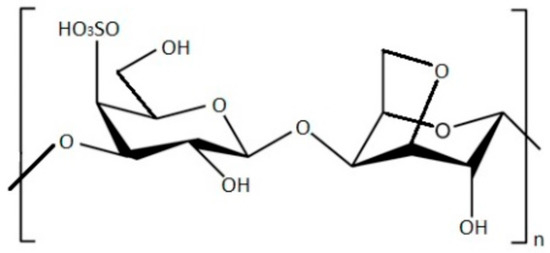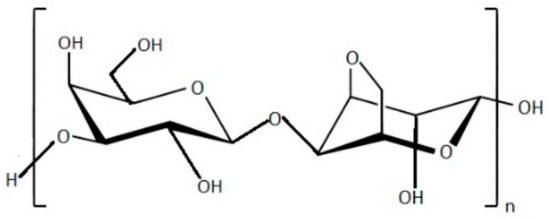These alginates are composed of polymers of alginic acid, with monomer units of β-D-mannuronic acid (M) and α-L-guluronic acid (G) joined by 1,4 linkages
[69][70][84,85].
The physicochemical and mechanical properties of alginate gels differ based on the M/G ratio and the length of the structure. A higher content of guluronic acid contributes to stronger gelling characteristics and the formation of more elastic gels. On the other hand, lower M/G ratios yield sturdy and brittle gels that demonstrate excellent heat stability but may exhibit syneresis during the freeze–thaw cycle
[50][67][54,82]. With its remarkable stabilizing and thickening abilities, alginate is extensively utilized in various food and medical applications
[50][67][71][54,82,86].
Due to their high hydrophilicity, alginates require the incorporation of additional components within the matrix to enhance water resistance. Furthermore, the presence of ions impacts the solubility of alginates, and the formation of gels relies on the type of bonds formed with cations
[50][67][54,82]. Introducing calcium into the alginate matrix enhances stability and resilience, offering potential for the creation of biodegradable materials with antimicrobial properties and nontoxic packaging
[71][72][86,87].
Due to their high hydrophilicity, alginates require the incorporation of other components into the matrix to enhance their resistance when in contact with water. Furthermore, the solubility of alginates is influenced by the presence of ions, and the formation of gels depends on the specific bonds formed with cations
[50][67][54,82].
3. Physical-Chemical Properties of Algal Phycocolloids
When evaluating the quality of an optimal material for the preparation of scaffolds or hydrogels, it is essential to consider mechanical properties such as tensile strength, elongation at break, heat resistance, and water vapour permeability. Tensile strength refers to the maximum stress a material can withstand before breaking when stretched or subjected to pressure. Generally, the tensile strength and Young’s modulus of plant fibres increase with higher cellulose content. Elongation at break is the ratio between the modified length and the initial length of the tested material after it fractures. It indicates the material’s ability to undergo shape changes without developing cracks in a matrix composed of natural polymers. Thermal resistance is a thermal property that represents the temperature difference a material can withstand
[73][105].
Vapour permeability, on the other hand, pertains to a material’s ability to allow the passage of vapours, such as water vapour or other gases. According to ISO 11092:1993
[74][106], water vapour permeability is a characteristic influenced by the water vapour resistance of a textile material or composite. A higher permeability value indicates that water and vapour can pass through the material more quickly, which is desirable.
The gelling properties of phycocolloids extracted from seaweeds vary depending on factors such as their structure, concentration in a solution, temperature, pH, and syneresis potential
[75][76][77][107,108,109]. The physicochemical attributes of phycocolloids are extensively influenced by factors such as species, environmental circumstances, extraction methodologies, and treatment procedures
[75][78][107,110]. Therefore, it is crucial to possess a comprehensive understanding of these factors to discover the most effective techniques for obtaining high-quality phycocolloids with optimal mechanical properties.
Carrageenans, in their salt form, exhibit significant gel strength
[79][111]. Among them, κ-carrageenan and ι-carrageenan gels remain stable at room temperature, while λ-carrageenan, being the only carrageenan soluble in cold water in its natural state, does not gel. The addition of cations enhances gel formation and strength in κ-carrageenan phycocolloids, as reported by Robal et al.
[80][112].
4. Therapeutic Applications of Phycocolloids
4.1. Carraagenan
Studies have provided evidence that carrageenans possess interesting biological activities
[81][82][83][84][85][57,58,143,144,145].
Polysaccharides characterized by the highest degree of sulfation and molecular weight, as well as the most notable in vitro antioxidant capacity, were obtained by sequentially extracting carrageenan from
Mastocarpus stellatus using water, acid, and alkali
[86][124]. Several studies have reported the enhanced activity of antioxidant enzymes, including catalase and superoxide, in the presence of carrageenans
[87][146].
Carrageenan has been demonstrated to induce apoptosis in various cancer cell lines. In particular, the red alga
Porphyra yezoensis has shown the ability to induce dose-dependent cancer cell death through apoptosis in in vitro tumour cell lines, while not exhibiting cytotoxicity against healthy cells
[88][125]. In the same study, the ability of carrageenans derived from
K. alvarezii to reduce the growth of liver, colon, breast, and osteosarcoma cell lines was detected. Additionally, several studies have reported the antiproliferative effects of carrageenans in in vitro cancer cell lines, as well as the inhibition of tumour growth in mice
[89][90][126,127]. Carrageenans have also exhibited antimetastatic effects by impeding the interaction of cancer cells with the basement membrane, inhibiting tumour cell growth, restraining tumour cell growth, and preventing adhesion to different substrates. However, the exact mechanisms of action remain unidentified.
In the beginning, λ-carrageenan obtained from the red algae
Gelidium cartilagenium exhibited antiviral properties against the influenza B virus or mumps virus
[91][130]. The antiviral activity of carrageenan is attributed to its capacity to shield specific cellular structures involved in virus–receptor interaction
[92][151]. The antiviral effect of λ-carrageenan can be attributed to the formation of enduring virion–carrageenan complexes that are irreversible, thus occupying the viral envelope sites necessary for virus attachment to host cells and hindering the virus from completing the infectious cycle
[93][94][152,153].
4.2. Alginate
Alginate hydrogels have also gained recognition for their various benefits in wound healing, including reduced scarring, minimal bacterial infection, promotion of cell proliferation, enhancement of cytokine activity, regulation of pain and inflammation, and creation of a moist wound environment
[38][95][42,155]. These hydrogels have also shown promise in tissue regeneration and drug delivery, as they possess a structural resemblance to the extracellular matrix, allowing them to perform critical functions in wound management
[96][156]. Dry films composed of alginate-based dressings are well suited for the treatment of superficial wounds that exude fluid. When an alginate-based dressing is applied to a wound with a moderate to high level of exudate, the alginate component within the dressing absorbs the fluid, effectively preventing maceration of the surrounding tissues and promoting wound healing
[37][41].
Alginate, a biomaterial that forms a gel upon the introduction of divalent calcium ions (Ca
2+), has been extensively investigated and employed in diverse domains such as wound healing, tissue engineering
[97][159], orthopaedics, and dental implant surgery. Its key benefits include low toxicity, cost-effectiveness, biocompatibility, and osteoconductive
[98][99][160,161].
Alginate hydrogels are utilized in the field of wound healing for the development of wound dressings
[100][101][102][103][162,163,164,165]. Numerous studies have demonstrated that drugs encapsulated within alginate hydrogels exhibit improved bioavailability compared to the free form of the drug directly applied to the wound site, leading to enhanced healing efficacy. Moreover, alginate hydrogels find extensive applications in tissue regeneration and cell encapsulation therapies
[104][105][106][107][108][109][110][166,167,168,169,170,171,172]. Alginate is commonly employed in the fabrication of capsules for cell encapsulation, which is often associated with cytotherapy treatments or the creation of cellular microcultures within more complex systems.
Alginate-derived hydrogels currently offer several advantages, making them suitable materials for applications in tissue engineering and regenerative medicine
[111][112][113][173,174,175]. The ionotropic alginate hydrogel biomaterial has gained significant attention in the fields of tissue engineering and regenerative medicine due to its biocompatibility, non-thrombogenic nature, mild gelation process, and similarity to the extracellular matrix (ECM). As a result, it has been widely utilized as a drug delivery system in these domains
[114][176].
4.3. Agar
Agar is a colloidal substance extracted from various red algae species that has gained widespread use in several sectors regarding biomedicine, chemicals, and the alimentary services, primarily as a gel-forming agent, thickener, water-holding agent, and stabilizer. The properties of agar, including its affordability, thermoreversibility, and high-strength nature, contribute to its increasing utilization across various industries. The chemical composition of agar, such as its sulphate, methoxyl, and sugar contents, influences its application in different products, and this composition can be affected by various extraction process variables. With its remarkable gelling power and the ease of extraction, agar holds promise as an environmentally friendly material due to its renewability and biodegradability. While previous research has focused on utilizing agar or alginate alone for oral drug delivery, there is limited exploration of blending agar with natural or synthetic polymers to modify its properties
[115][185].
Agarose solutions exhibit the ability to form reversible gels upon cooling below 40 °C through physical cross-linking
[65][74]. This property, along with its unique mechanical characteristics and biocompatibility, has made agarose widely used in various applications such as cosmetics, biomedical applications, cell therapies, drug delivery, tissue engineering, and molecular biology. While native agarose hydrogels are generally not suitable for cell adhesion and growth due to their high hydrophilicity and antiadhesive properties, this feature is advantageous in hydrogel dressings. It prevents tissue ingrowth into the matrix, minimizing potential damage to the healing wound upon removal
[116][140].
The inclusion of agar in the hydrogel led to notable improvements in mechanical properties, including increased compressive strength and shear stress, which can be attributed to the higher Young’s modulus of the added compound. Importantly, the addition of agar enabled injectability of the hydrogel through a syringe needle, overcoming a significant limitation of using GG as a biomedical device. The morphology of the materials exhibited an appropriate porous microstructure, with a porosity range of 70 to 180 µm, facilitating optimal water uptake for improved mechanical properties, as well as effective diffusion of nutrients, oxygen, and cell ingrowth.
5. Phycocolloids as Potential Drug Delivery System
The common employed practice for regulating the release of drugs is through the utilization of oral extended-release tablets consisting of a solitary hydrophilic matrix system. The properties of carrageenan, such as its elevated molecular weight, high viscosity, and gelling capabilities, make it a suitable choice for serving as the matrix in the creation of extended-release tablets. However, its capacity for loading drugs is limited. In order to surmount this constraint, the combination of polymers has been extensively employed over many years to effectively adjust drug release and achieve desirable outcomes
[117][188].
The impact of polymer blends that include carrageenans (τ, ʎ) and cellulose ethers (HPMC, sodium carboxymethylcellulose, methylcellulose, hydroxypropyl cellulose) on the release of ibuprofen from tablets, produced through direct compression, was examined. Most of the formulations displayed consistent release patterns, and the release of ibuprofen was sustained for a duration of 12–16 h
[118][189].
Carrageenan has demonstrated its ability to regulate early drug dumping, making it a promising option for achieving consistent drug release. A study revealed that incorporating as much as 40% ʎ-carrageenan in the matrix (ʎ-carrageenan-HPMC) effectively controlled the initial release of drugs, such as salbutamol sulphate and chlorpheniramine maleate, with release profiles closely resembling linearity
[119][192]. The mechanisms responsible for the reduction in burst release were explained by the interaction between the basic drug and ʎ-carrageenan at the surface of the tablet, which hindered drug diffusion, while the main determinant of drug release was the erosion of the carriers
[120][194]. The combined effect of water uptake, erosion, and interaction may result in prolonged drug release exceeding 24 h
[121][195].
Chitosan is a cationic polymer derived from deacetylation of chitin, consisting of (1-4)-2-amino-2-deoxy-β-D-glucan. It possesses favourable processability and reactivity due to the presence of free hydroxyl and amino groups in its structure
[122][196]. With its high hydrophilicity and semicrystalline nature, chitosan exhibits hydrogen bonding with water molecules, unlike many hydrocolloids that have anionic properties in aqueous environments. When chitosan is dissolved in acidic solutions, it becomes cationic and soluble. This leads to a strong attraction between chitosan and these hydrocolloids when they are blended together
[123][197].
Furthermore, the results indicated that chitosan-λ-carrageenan-based matrices exhibited promise as controlled-release drug carriers due to their lower sensitivity to pH and ionic strength compared to chitosan-κ-carrageenan and chitosan-ι-carrageenan matrices
[124][206]. Carrageenan maintains a certain degree of ionization even at low pH due to its low pKa value
[125][207], making it suitable for the preparation of gastric floating tablets
[126][208].



